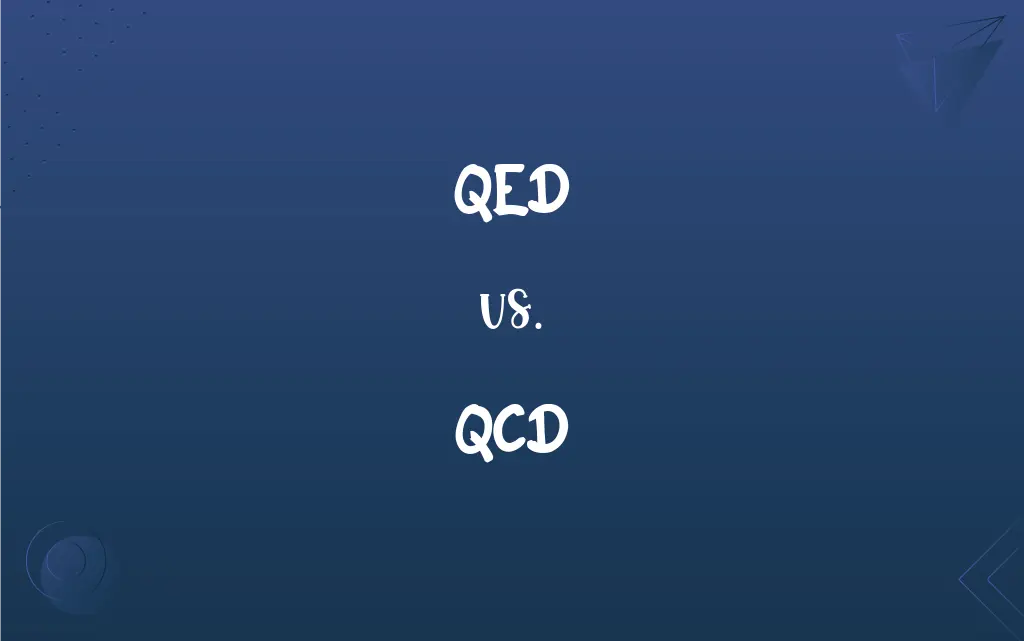QED vs. QCD: What's the Difference?
By Aimie Carlson & Janet White || Published on March 4, 2024
QED (Quantum Electrodynamics) focuses on the electromagnetic interactions among particles, while QCD (Quantum Chromodynamics) explains the strong force binding quarks and gluons within nucleons.

Key Differences
QED, or Quantum Electrodynamics, is a quantum field theory that describes how light and matter interact, emphasizing the electromagnetic force between charged particles. In contrast, QCD, Quantum Chromodynamics, delves into the strong interaction, the force responsible for holding quarks together in protons and neutrons.
QED is renowned for its precision in predicting phenomena like the Lamb shift and anomalous magnetic moments of electrons, QCD characterizes the complex behaviors of hadrons in high-energy physics experiments, showcasing the confinement of quarks and gluons.
A key distinction lies in the force carriers: QED is mediated by photons, which are massless and chargeless, facilitating long-range electromagnetic interactions. QCD's interactions are governed by gluons, which carry color charge and result in the short-range, but immensely strong, strong force.
The mathematical frameworks of both theories highlight their differences; QED's perturbation theory works well due to the relatively weak electromagnetic force, allowing for highly accurate predictions. QCD's perturbative techniques are limited to high-energy scenarios, with non-perturbative methods required to tackle low-energy quark confinement.
Both theories contribute to the Standard Model of particle physics, with QED explaining electromagnetic phenomena across a vast scale, from atomic to cosmic, and QCD revealing the internal structure of matter at the most fundamental level, providing insights into the early universe and exotic states of matter like quark-gluon plasma.
ADVERTISEMENT
Comparison Chart
Force Concerned
Electromagnetic
Strong
Force Carriers
Photons
Gluons
Interaction Range
Long-range
Short-range
Governing Particles
Electrons, positrons, photons
Quarks, gluons
Perturbative Predictability
High (for weak electromagnetic interactions)
Limited (effective in high-energy scenarios)
ADVERTISEMENT
QED and QCD Definitions
QED
A quantum theory of electromagnetic interactions.
QED predicts the scattering of photons by electrons.
QCD
The strong force charge.
In QCD, gluons carry color charge, mediating the strong force.
QED
A process to remove infinities from calculations.
QED was the first theory where renormalization was successfully applied.
QCD
Quarks cannot be isolated.
QCD predicts the confinement of quarks within protons and neutrons.
QED
Describes interactions via photon exchange.
QED explains the attraction between electrons and protons through photon exchange.
QCD
The mechanism of strong force interaction.
QCD describes the binding of quarks by gluon exchange.
QED
The difference in energy levels due to electromagnetic self-energy.
QED accurately calculates the Lamb shift in the hydrogen atom.
QCD
A theory of the strong interaction.
QCD explains how protons are stable despite the repulsion between their quarks.
QED
Visual representations of particle interactions.
QED utilizes Feynman diagrams to depict electron-photon interactions.
QCD
Strong force weakens at high energies.
QCD reveals that quarks behave almost freely in high-energy conditions.
QCD
Quantum chromodynamics.
QCD
A theory of strong interactions between elementary particles (including the interaction that binds protons and neutrons in the nucleus); it assumes that strongly interacting particles (hadrons) are made of quarks and that gluons bind the quarks together
FAQs
What does QCD stand for?
Quantum Chromodynamics (QCD) is the theory of the strong interaction between quarks and gluons.
How do QED and QCD fit into the Standard Model?
Both are integral parts of the Standard Model, with QED governing electromagnetic interactions and QCD describing the strong force.
What is QED?
Quantum Electrodynamics (QED) is the theory that describes how light and matter interact through the electromagnetic force.
What are the force carriers in QED and QCD?
In QED, the force carrier is the photon, while in QCD, it is the gluon.
What challenges does QCD present in theoretical physics?
The complexity of quark-gluon interactions and confinement poses significant challenges, especially at low energies.
Can QED and QCD predictions be tested experimentally?
Yes, both theories have been extensively tested and confirmed through high-precision experiments.
Why is renormalization important in QED?
It allows physicists to make finite predictions by removing infinities from calculations.
How do Feynman diagrams differ between QED and QCD?
QED diagrams involve photon exchanges, while QCD diagrams include gluon exchanges and can be more complex due to the strong interaction.
What unique feature does QCD have compared to QED?
QCD exhibits confinement and asymptotic freedom, unique to the strong force.
How do gluons differ from photons?
Gluons carry color charge and mediate the strong force, whereas photons are chargeless and mediate electromagnetic interactions.
What role does the color charge play in QCD?
Color charge is fundamental to QCD, governing the interactions between quarks and gluons.
What does QED contribute to our understanding of the universe?
It provides a comprehensive framework for understanding electromagnetic interactions across the universe.
What experimental evidence supports QCD?
High-energy particle collider experiments provide strong support for QCD through observations of quark-gluon plasma and jet formation.
How do QED and QCD influence modern technology?
QED underpins technologies like lasers and semiconductors, while QCD research contributes to understanding fundamental particles, impacting materials science and medical imaging technologies.
Why is QED important in physics?
QED is crucial for understanding electromagnetic processes and has led to precise predictions and explanations of atomic phenomena.
How does QED explain the Lamb shift?
QED accounts for the Lamb shift as a result of vacuum fluctuations and electromagnetic self-energy effects.
Why are high energies needed to probe QCD?
High energies allow quarks and gluons to manifest asymptotic freedom, making their properties more apparent.
What is asymptotic freedom in QCD?
It's the phenomenon where the strong force becomes weaker as the energy scale increases.
Can quarks exist independently outside of hadrons?
No, QCD predicts that quarks are permanently confined within hadrons.
How does QCD explain the stability of protons?
Through the strong force mediated by gluons, keeping quarks bound tightly together.
About Author
Written by
Aimie CarlsonAimie Carlson, holding a master's degree in English literature, is a fervent English language enthusiast. She lends her writing talents to Difference Wiki, a prominent website that specializes in comparisons, offering readers insightful analyses that both captivate and inform.
Co-written by
Janet WhiteJanet White has been an esteemed writer and blogger for Difference Wiki. Holding a Master's degree in Science and Medical Journalism from the prestigious Boston University, she has consistently demonstrated her expertise and passion for her field. When she's not immersed in her work, Janet relishes her time exercising, delving into a good book, and cherishing moments with friends and family.































































